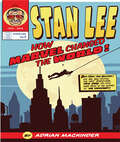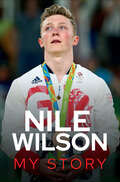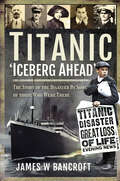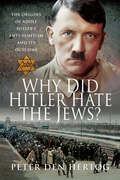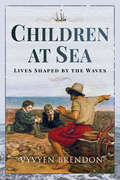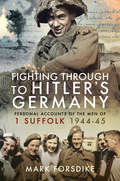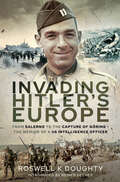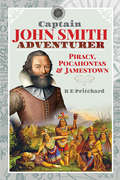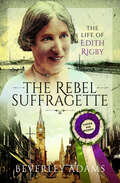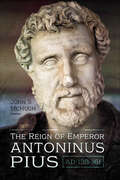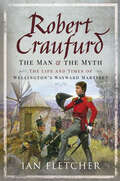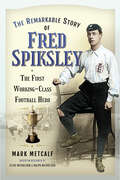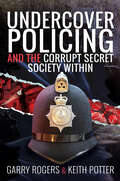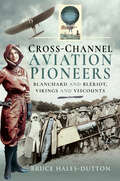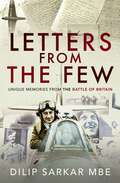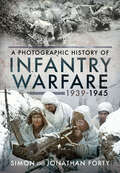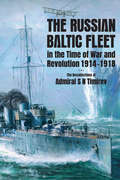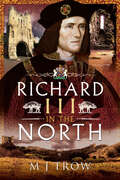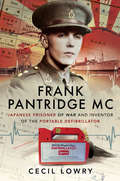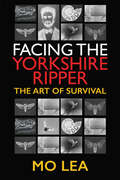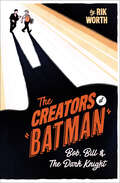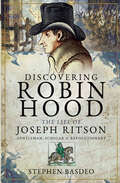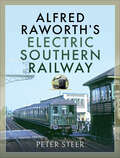- Table View
- List View
Stan Lee: How Marvel Changed The World
by Adrian MackinderDiscover the astonishing history of modern American entertainment, seen through the eyes of a pop-culture icon who lived for nearly 100 years.Stan Lee: How Marvel Changed the World is not just another biography. It is a journey through twentieth century American history, seen through the life of a man who personified the American Dream. This book shows how Stan Lee’s life reflects the evolution of American entertainment, society and popular culture throughout the 1900s and beyond. Along the way, bold questions will be asked. Was Stan Lee himself a superhuman creation, just a mask to protect his true, more complicated secret identity? Just like the vibrant panels of the comics he wrote, Lee’s life, it seems, is never black and white. Sourced from Lee’s own words, this book also includes brand new and exclusive interviews with Marvel comic book creators, for whom Lee’s work proved an invaluable inspiration. Upbeat, accessible and fun, this book is told with a glint in the eye and a flair for the theatrical that would make Stan Lee proud. This is a bold celebration of the power of storytelling and a fitting tribute to Stan Lee’s enduring legacy. Excelsior!
Nile Wilson: My Story
by Nile WilsonThe down-to-earth Olympic medalist tells the story of the pressures and mental health struggles behind his successful gymnastic career. Nile Wilson is known to many as the gymnast who won a bronze medal for Great Britain at the 2016 Rio Olympics, and England&’s most successful gymnast ever at a Commonwealth Games following his five medals in 2018. Yet, Nile is so much more than just an athlete. A YouTuber with over a million subscribers, a social media influencer, a successful businessman and entrepreneur, Nile is also an advocate for mental health awareness, and has been very open about his own personal struggles. In this book, Nile gives an unprecedented look into his true battle to be fit and ready for the Tokyo 2020 Olympics—throughout the Games and the aftermath. The public perception of Nile Wilson is focused on his humor, openness, and how down-to-earth he is. This book reveals the struggles behind the smiles, from the brutal reality of performing at an elite sporting level, to the mental health battles Nile has had to fight—and continues to fight—every day.
Titanic: 'Iceberg Ahead'
by James W. BancroftUsing a unique approach, the author explores the disaster through the lives of fifty people linked to the sinking, from all walks of life and geographical regions.To have sailed on ‘the voyage of the century’ aboard White Star Line’s RMS Titanic – described at the time as ‘a floating palace’ – was like being one of the first passengers to fly on Concorde. On 10 April 1912, people from all walks of life began embarking on Titanic, then the largest ship afloat, for what was to be the trip of a lifetime on the ship’s maiden voyage across the north Atlantic. Many were looking forward to starting new lives in the United States. However, just before midnight on Sunday, 14 April 1912, Titanic’s crew began to send out distress signals stating, ‘We have struck an iceberg.' The liner had been steaming at speed when it collided with an enormous iceberg which stripped off her bilge under the waterline for more than 100 yards, opened up five of the front compartments and flooded the coal bunker servicing one of the boilers. The damage was fatal, and some three hours after the disaster began to unfold the last visible part of Titanic slipped beneath the waves. There were only sixteen lifeboats and four collapsible dinghies – which was completely insufficient for the number of passengers making the crossing. As a consequence, more than 1,500 passengers and crew died: two out of every three people onboard perished. Much has been written about the Titanic disaster, and it has been the subject matter for several films. The author is well-known for his depth of research and his attention to detail, and in a new style of format, he has selected fifty people involved in the disaster, and by using their specific eyewitness accounts he has managed to make the confusing situation much clearer, making it possible for the reader to experience the dreadful events as they unfolded. The book also includes biographical tributes to the fifty people, who came from all walks of life and geographical regions, telling who they were, their experiences during the disaster, and what happened to those who were fortunate enough to survive.
Why Did Hitler Hate the Jews?: The Origins of Adolf Hitler's Anti-Semitism and its Outcome
by Peter den HertogThis investigation into the Nazi leader’s mindset is “an inherently fascinating study . . . a work of meticulously presented and seminal scholarship”(Midwest Book Review).Adolf Hitler’s virulent anti-Semitism is often attributed to external cultural and environmental factors. But as historian Peter den Hertog notes in this book, most of Hitler’s contemporaries experienced the same culture and environment and didn’t turn into rabid Jew-haters, let alone perpetrators of genocide. In this study, the author investigates what we do know about the roots of the German leader’s anti-Semitism. He also takes the significant step of mapping out what we do not know in detail, opening pathways to further research.Focusing not only on history but on psychology, forensic psychiatry, and related fields, he reveals how Hitler was a man with highly paranoid traits, and clarifies the causes behind this paranoia while explaining its connection to his anti-Semitism. The author also explores, and answers, whether the Führer gave one specific instruction ordering the elimination of Europe’s Jews, and, if so, when this took place.Peter den Hertog is able to provide an all-encompassing explanation for Hitler’s anti-Semitism by combining insights from many different disciplines—and makes clearer how Hitler’s own particular brand of anti-Semitism could lead the way to the Holocaust.
Children at Sea: Lives Shaped by the Waves
by Vyvyen BrendonThe author of Children of the Raj and Prep School Children examines the historical lives of eight children who grew up out on the oceans.Children at sea faced even more drastic separations from loved ones than those sent “home” from India or those packed off to English boarding schools at the age of seven, the subjects of Vyvyen Brendon’s previous books. Captured slaves, child migrants and transported convicts faced an ocean passage leading nearly always to lifelong exile in distant lands. Boys apprenticed as merchant seamen, or enlisted as powder monkeys, or signed on as midshipmen, usually progressed to a nautical career fraught with danger and broken only by fleeting periods of home leave. “Solitary among numbers,” as Admiral Collingwood described himself, they could be not just physically at risk but psychologically adrift—at sea in more ways than one.Rather than abandoning sea borne children as they approached adulthood, therefore, Vyvyen follows whole lives shaped by the waves. She focusses on eight central characters: a slave captured in Africa, a convict girl transported to Australia, a Barnardo’s lass sent as a migrant to Canada, a foundling brought up in Coram’s Hospital who ran away to sea, and four youths from contrasting backgrounds dispatched to serve as midshipmen. Their social origins as well as their maritime ventures are revealed through a rich variety of original source material discovered in scattered archives.These brine-encrusted lives are resurrected both for their intrinsic interest and because they speak for thousands of children, cast off alone to face storms and calms, excitement and monotony, fellowship and loneliness, kindness and abuse, seasickness and ozone breezes, loss and hope. This book recounts stories that might otherwise have sunk without trace like so much juvenile flotsam. They are sometimes inspiring, sometimes heart-rending and always compelling. Children at Sea embarks on a fresh voyage and explores a world of new experience.
Fighting Through to Hitler's Germany: Personal Accounts of the Men of 1 Suffolk 1944–45
by Mark Forsdike&“The real story of how the Second World war was won in Europe . . . Packed with the personal stories of the men who were there.&” —Clash of Steel After landing on D-Day, 1st Battalion, The Suffolk Regiment fought through France, Holland and into Germany as part of the 3rd (British) Infantry Division. Ever cheerful, the Battalion were opposed by an increasingly ruthless enemy determined to deny the invader their homeland. As the campaign developed, 1 Suffolk acquired an enviable reputation for getting the job done with the minimum of fuss. Inevitably casualties mounted up and, of the 850 who landed on D-Day, just 178 were still serving on VE-Day; 215 had been killed and 640 wounded. The Battalion&’s success was due in large measure to fine leadership and all four commanding officers went on to enjoy distinguished careers. But without the stalwart fighting spirit and comradeship of all ranks none of the Battalion&’s achievements would have been possible. This fine book draws on the testimonies of officers and men who served in this historic campaign. Recognition of the fighting record of 1 Suffolk is long overdue and the author is to be congratulated for pulling together these inspiring first-hand accounts along with many previously unpublished photographs.A Soldier Magazine Top Read of the Year&“Brings life to the story of in this case World War II, and gives an insight into what this war was like. The author deserves praise for the way he has presented the words of these men, as it makes for a very engaging read.&” —Armorama
Invading Hitler's Europe: From Salerno to the Capture of Göring—The Memoir of a US Intelligence Officer
by Roswell K. DoughtyA firsthand account of a US Army officer’s part in the liberation of Europe during World War II—from North Africa into the heart of the Third Reich. After graduating from Boston University, Roswell K. Doughty became an Intelligence Officer with the US 36th (Texas) Division. He subsequently saw action in North Africa, then at the disastrous Salerno landings in Italy—where the Allied divisions involved suffered 4,000 casualties—about which the author reveals that suspected intelligence breaches led to the Allies’ plans becoming known to the Germans.Doughty was involved in the grueling battles against the formidable German defenses of the Gustav Line, particularly in the tragic failed attempt to cross the Gari river (Battle of the Rapido River, January 1944) and the struggle to conquer Monte Cassino. After the Anzio landings and the liberation of Rome, Doughty and his infantry regiment, the 141st, took part in the invasion of Southern France in Operation Dragoon, fighting its way up the Rhône River and advancing up to the River Moselle in December 1944. In March 1945, his unit breached the Siegfried Line and crossed into the Germany itself. As an Intelligence Officer, it was also part of Doughty’s duties to interrogate enemy prisoners, which led him to being involved in the capture and detention of Reichsmarschall Go¨ring and in negotiating the surrender of the still-armed and hostile German First Army in May 1945.These are Doughty’s candid recollections from his ground-level point of view. They form a story of survival and a cause for reflection about courage, camaraderie, and the nature of war.
Captain John Smith, Adventurer: Piracy, Pocahontas & Jamestown
by R. E. PritchardThe swashbuckling life of the Elizabethan explorer and colonial governor is vividly recounted in this historical biography.Captain John Smith is best remembered for his association with Pocahontas, but this was only a small part of an extraordinary life filled with danger and adventure. As a soldier, he fought the Turks in Eastern Europe, where he beheaded three Turkish adversaries in duels. He was sold into slavery, then murdered his master to escape. He sailed under a pirate flag, was shipwrecked, and marched to the gallows to be hanged, only to be reprieved at the eleventh hour. All this before he was thirty years old.Smith was one of the founders of Jamestown, the first permanent English settlement in America. He faced considerable danger from the Native Americans as well as from competing factions within the settlement itself. In the face of all this, Smith’s leadership saved the settlement from failure.
Captain John Smith, Adventurer: Piracy, Pocahontas & Jamestown
by R. E. PritchardThe swashbuckling life of the Elizabethan explorer and colonial governor is vividly recounted in this historical biography.Captain John Smith is best remembered for his association with Pocahontas, but this was only a small part of an extraordinary life filled with danger and adventure. As a soldier, he fought the Turks in Eastern Europe, where he beheaded three Turkish adversaries in duels. He was sold into slavery, then murdered his master to escape. He sailed under a pirate flag, was shipwrecked, and marched to the gallows to be hanged, only to be reprieved at the eleventh hour. All this before he was thirty years old.Smith was one of the founders of Jamestown, the first permanent English settlement in America. He faced considerable danger from the Native Americans as well as from competing factions within the settlement itself. In the face of all this, Smith’s leadership saved the settlement from failure.
The Rebel Suffragette: The Life of Edith Rigby
by Beverley AdamsThe suffragette movement swept the country in the late 19th and early 20th centuries. Led by the Pankhurst’s, the focus of the movement was in London with demonstrations and rallies taking place across the capital. But this was a nationwide movement with a strong northern influence with Edith Rigby being an ardent supporter. Edith was a controversial figure, not only was she was the first woman to own and ride a bicycle in her home town but she was founder of a school for girls and young women. Edith followed the example of Emmeline Pankhurst and her supporters and founded the Preston branch of the Women’s Social and Political Union. She was found guilty of arson and an attempted bomb attack in Liverpool following which she was incarcerated and endured hunger strike forming part of the ‘Cat and Mouse’ system with the government. During a political rally with Winston Churchill Edith threw a black pudding at a MP. There are many tales to tell in the life of Edith Rigby, she was charismatic, passionate, ruthless and thoroughly unpredictable. She was someone who rejected the accepted notion of what a woman of her class should be the way she dressed and the way she ran her household but she was independent in mind and spirit and always had courage in her own convictions. As a suffragette, she was just as effective and brave as the Pankhurst women. This is the story of a life of a lesser known suffragette. This is Edith’s story.
The Reign of Emperor Antoninus Pius, AD 138–161
by John S. McHughThe reign of Antoninus Pius is widely seen as the apogee of the Roman Empire yet, due to gaps in the historical sources, his reign has been overlooked by modern historians. He is considered one of the five good emperors of the Antonine dynasty under whom the pax Romana enabled the empire to prosper, trade to flourish and culture to thrive. His reign is considered a Golden Age but this was partly an image created by imperial propaganda. There were serious conflicts in North Africa and Dacia, as well as a major revolt in Britain. On his death the empire stood on the cusp of the catastrophic invasions and rebellions that marked the reign of his successor Marcus Aurelius. Antoninus Pius became emperor through the hand of fate, being adopted by Hadrian only after the death of his intended heir, Lucius Aelius Caesar. His rule was a balancing act between securing his own safety, securing the succession of his adopted heir and denying opportunities for conspiracy and rebellion. ‘Equanimity’ was the last password he issued to his guards as he lay on his death bed. In the face of the threats and challenges he remained calm and composed, providing twenty-three years of stability; a calm before the storms that gathered both within and beyond Rome’s borders.
Robert Craufurd: The Life and Times of Wellington's Wayward Martinet
by Ian FletcherTo most students of the Peninsular War the name Robert Craufurd evokes images of a battle-hardened martinet, flogging his men across Portugal and Spain, driving them hard and generally taking a tough stance against anything and everything that did not meet with his own strict disciplinarian code. But that is only a partial picture of this most complex character, and it is the other side of Craufurd’s personality that is revealed in this, the first full-length biography to be written in the last hundred years. Craufurd’s letters to his wife are published here for the first time, and they show that he was a far more interesting and varied man in his private life than he appeared to be on campaign. Ian Fletcher follows Craufurd’s controversial career from India, Ireland and South America to the Iberian Peninsula where he achieved immortality as one of Wellington’s finest generals.
The Remarkable Story of Fred Spiksley: The First Working-Class Football Hero
by Mark MetcalfGainsborough’s Fred Spiksley was one of the first working class youngsters in 1887 to live ‘the dream’ of becoming a professional footballer, before later finding a role as a globe-trotting coach. He thus dodged the inevitability of industrial, poorly paid, dangerous labour. Lightning fast, Spiksley created and scored hundreds of goals including, to the great joy of the future Queen Mary who chased him down the touchline, three against Scotland in 1893. The outside left scored both Sheffield Wednesday’s goals in the 2-1 defeat of Wolves in the 1896 FA Cup Final at the Crystal palace. Forced by injury to stop playing at aged 36, Spiksley adventured out into the world. He acted with Charlie Chaplin, escaped from a German prison at the start of the First World War and later made the first ‘talking’ football training film for youngsters. As a coach/manager he won titles in Sweden, Mexico, the USA and Germany, becoming the last Englishman to coach a German title-winning team with 1FC Nuremburg in 1927. He coached in Barcelona in 1932 and it was only after his involvement had exceeded 50 years, during which time, as this book explains, the game changed dramatically, did Spiksley’s football career end. As an addicted gambler and womaniser, Spiksley had his problems away from football. However, he was beloved by his football fans, including Herbert Chapman, the greatest manager of that era in English football who, towards the end of his life, picked him in his finest XI.
Undercover Policing and the Corrupt Secret Society Within
by Garry Rogers Keith PotterA former police officer reveals all in a shocking autobiography “detailing his time undercover amongst some of the UK’s toughest criminals” (Daily Mirror).Garry Rogers played a key role in one of the UK’s most successful undercover policing operations, targeting the football hooliganism which blighted the domestic and international game. From Old Trafford to Turkey and Sweden to Sardinia, this working class lad turned undercover cop infiltrated some of the most notorious hooligan gangs at club and England level as part of Greater Manchester Police’s groundbreaking Omega Unit.When the force extended its undercover policing operations to target serious and violent crime, it was Garry who gained the trust of armed robbers, drug dealers and a murderer securing the evidence to take them off the streets, often for many years.But after five years at the cutting edge of covert operations, and with a new, inexperienced and ultimately corrupt officer in charge of the unit, Garry found himself dangerously exposed to violent criminals living just minutes from his family home. And when he turned to the force for support he was met with a wall of silence, accusations, and what one chief constable later described as a Masonic conspiracy that eventually pushed him out of the job after 28 years. Now he’s determined to tell his story—the truth, the whole truth and nothing but the truth.
Undercover Policing and the Corrupt Secret Society Within
by Garry Rogers Keith PotterA former police officer reveals all in a shocking autobiography “detailing his time undercover amongst some of the UK’s toughest criminals” (Daily Mirror).Garry Rogers played a key role in one of the UK’s most successful undercover policing operations, targeting the football hooliganism which blighted the domestic and international game. From Old Trafford to Turkey and Sweden to Sardinia, this working class lad turned undercover cop infiltrated some of the most notorious hooligan gangs at club and England level as part of Greater Manchester Police’s groundbreaking Omega Unit.When the force extended its undercover policing operations to target serious and violent crime, it was Garry who gained the trust of armed robbers, drug dealers and a murderer securing the evidence to take them off the streets, often for many years.But after five years at the cutting edge of covert operations, and with a new, inexperienced and ultimately corrupt officer in charge of the unit, Garry found himself dangerously exposed to violent criminals living just minutes from his family home. And when he turned to the force for support he was met with a wall of silence, accusations, and what one chief constable later described as a Masonic conspiracy that eventually pushed him out of the job after 28 years. Now he’s determined to tell his story—the truth, the whole truth and nothing but the truth.
Cross-Channel Aviation Pioneers: Blanchard and Blériot, Vikings and Viscounts
by Bruce Hales-DuttonThe stories of the daredevils who attempted to fly over the English Channel—a history filled with triumphs, tragedies, and colorful characters.On July 25, 1909, a dapper, mustachioed Frenchman flying a flimsy, diaphanous airplane changed the status of a great nation. “England is no longer an island,” declared the Daily Mail. Lord Northcliffe, the newspaper’s proprietor, had put up the £1,000 prize for the first flight of the English Channel by the pilot of an airplane.In securing the prize for one of aviation’s most celebrated firsts, Louis Blériot had beaten his Anglo-French rival Hubert Latham. Six days earlier, Latham had become the first airman to make a forced landing on water when the engine of his elegant Antoinette monoplane failed while he attempted the crossing.This book explores the triumphs, tragedies, and many milestones in cross-channel flight, beginning back in July 1785 when John-Pierre Blanchard and John Jeffries made the first crossing, by balloon. Other flyers quickly followed Blériot so that Pierre Prier made the first non-stop London-Paris flight in April 1911 and Harriet Quimby became the first woman to fly the Channel a year later—though her historic accomplishment was overshadowed by the Titanic catastrophe.The book also charts other events in cross-Channel aviation such as the midair collision between the UK and France that led to a rudimentary system of air traffic control; the first cat to make the flight; the popular car ferry services of the 1950s and 1960s; and the coming of the jets—providing a colorful history of the era before the debut of the famed Channel Tunnel.
Letters from the Few: Unique Memories from the Battle of Britain
by Dilip SarkarFascinated by the Battle of Britain from an early age, as a young man Dilip Sarkar realized that recording and sharing the Few’s memories was of paramount importance. At the time, back in the mid-1980s, membership of the Battle of Britain Fighter Association was well populated and the then Honorary Secretary, the now late Wing Commander Pat Hancock DFC, OBE, supported Dilip’s research by forwarding letters to individual pilots of interest. Those members of the Few included a wide-range of personalities, from famous airmen like Group Captain Peter Townsend and Air Marshal Sir Denis Crowley-Milling, to the ‘also rans’, as Battle of Britain Hurricane pilot Peter Fox famously described himself and peers. Indeed, it was Peter’s ‘also rans’ that were of the greatest interest to Dilip, who recognized that whilst many famous and distinguished pilots had either published personal memoirs or had biographies written about them, lesser-lights had no platform to record and share their experiences. This Dilip became dedicated to resolving. For many years, Dilip enjoyed prolific correspondence with the Few. These letters – hundreds of them – now represent a unique primary source, confirming the incredibly close relationship the author enjoyed with his heroes and high esteem in which they likewise held him. Over the years, Dilip’s published work has enormously benefited from his unique knowledge of the people involved through this very personal association, the memories collated providing his books a real ‘human’ touch. As the Few sadly fade away, it is only now that the significance of Dilip’s correspondence, industry and archive arising are becoming truly apparent. In Letters From The Few, Dilip shares with us, for the first time, a small selection of his correspondence with Battle of Britain fighter pilots, providing us an inspirational insight into the immeasurable value of this research and personalities involved.
Infantry Warfare, 1939–1945: A Photographic History
by Simon Forty Jonathan FortyThe infantry can always be found at the sharp end of the battlefield. You may be able to crush an opponent with armour or artillery, but there’s only one way to take and hold ground and that’s with riflemen – the ‘poor bloody infantry’. And it is the infantrymen of the Second World War – from all sides, Allied and Axis – who are the subject of this highly illustrated history. It uses over 400 wartime photographs plus contemporary documents and other illustrations to show the developments in equipment, training and tactical techniques and to give an insight into the experience of the infantry soldier during the conflict. Although the infantry were critical to the war effort, their contribution is often overshadowed by the more dramatic roles played by soldiers with more specialized skills – like tank crew, paratroopers and special forces. They also suffered devastating casualties, in particular during the last phase of the war in the west when around 20 per cent of an infantry division’s riflemen were likely to die and over 60 per cent could expect to be wounded. So as well as describing how the infantry fought, the authors look at the motivation which kept them fighting in awful conditions and despite brutal setbacks. The result is a thorough, detailed and revealing portrait of infantry warfare over seventy years ago.
The Russian Baltic Fleet in the Time of War and Revolution, 1914–1918: The Recollections of Admiral S N Timiryov
by Stephen C. EllisThe first English-language edition. “A useful read for anyone interested in early 20th century Russia and naval operations in the Great War.” —StrategyPageRear Admiral S. N. Timiryov, was well placed to make observations on the character of many of the significant commanding officers and also many of the operations of the Baltic Fleet from the beginning of the war in 1914 up to exit from it in 1918. He trained with many of the key figures and shared battle experience with them in the Russo-Japanese War of 1904-05 and the siege of Port Arthur; and he spent a year in Japan as a prisoner of war with a number of them. In his subsequent career in the Navy he had roles which brought him into contact with new recruits as well as with many serving officers, and as the Executive Officer on the imperial yacht Shtandart for some years, he came into contact with senior members of the navy establishment and of the government, including the imperial household. The translation of these memoirs brings an important and authoritative historical source to those interested in Russian or naval history who are unable to access them in the original Russian.“An excellent addition to the historiography of the Imperial Russian Navy during the twilight of its existence. A key resource for scholars of the Baltic Fleet and naval aspects of the Russian Revolution.” —The Northern Mariner “The coverage of Russian operations, command structure dynamics, and their impact on operational capability make it worthy of recommendation.” —Australian Naval Institute
Richard III in the North
by M. J. TrowThis enlightening biography examines the life and short reign of England’s most controversial king and his relationship to the region he loved.Was Richard III the world’s most wicked uncle, or is he merely the victim of historical slander? Forever associated with the murder of his nephews, he was the last king to die in battle, in 1485. His life was as spectacular as the discovery of his bones under a Leicester car park five centuries later—an event that revived age-old debates.This detailed look at Richard’s life focuses on the area that he loved and made his own. As Lord of the North, he had castles at Middleham and Sheriff Hutton, Penrith, and Sandal. He fought the Scots along the northern border and on their own territory. His son was born at Middleham and was invested as Prince of Wales at York Minster, where Richard planned to set up a college of 100 priests.His white boar device can be found in obscure corners of churches and castles; his laws gave rights to his loyal subjects north of the Trent. And when he felt threatened during the Wars of the Roses, it was to the men of the North that he turned for support and advice. M.J. Trow’s biography demonstrates that the North is the key to understanding this fascinating and complex king.
Frank Pantridge MC: Japanese Prisoner of War and Inventor of the Portable Defibrillator
by Cecil LowryA biography of the British World War II veteran and Japanese POW camp survivor who went on to create a life-saving device.Countless thousands of men and women around the world have good reason to be thankful that Frank Pantridge survived three and a half years of brutal Japanese captivity. Had he not, they too would in all probability have died too.Taken prisoner at the fall of Singapore in February 1942, Frank was forced to endure appalling deprivation. Conditions on the Burma railway were notorious, and the death rate was horrendous.On returning to Belfast in late 1945, Frank specialized in heart diseases. Convinced that the prompt application of electric shock after cardiac arrest could save lives, he reasoned that ventricular defibrillation should be applied not just in hospitals but in the workplace, the home, the street or ambulance.His first “portable” defibrillator was produced in 1965 and over the intervening years evolved into the compact units so prevalent today. The importance of Pantridge’s invention was well demonstrated when U.S. President Lyndon B. Johnston’s life was saved in 1972.This stirring biography reveals the full story of a remarkable man who survived against the odds to save countless lives.Praise for Frank Pantridge MC“Cecil Lowry's book describes a man who…survived against all the odds. . . . A fascinating and moving story.” —Books Monthly (UK)
Facing the Yorkshire Ripper: The Art of Survival
by Mo LeaDecades after her brutal attack by the notorious serial killer, an artist tells her story of survival and recovery in this uplifting memoir.Mo Lea was a young art student in Leeds when her life was changed forever by a deadly assault. On October 25th, 1980, serial killer Peter Sutcliffe attacked her with a hammer and stabbed her with a screwdriver. Surviving with a fractured skull and PTSD, Mo spent years wrestling with a morbid narrative that cast her as a victim. Now Mo offers a fresh perspective on her life, sharing valuable insight into her successful recovery process. While art had always been important to her, it became a vital outlet for exploring her pain, her anger, and her ultimate triumph over them. Drawing a meticulous portrait of Sutcliffe, she then found catharsis in tearing it to bits—ripping up the Ripper.In candid words and stirring illustrations, Mo reclaims her own story, telling of her journey from tragic despair to calmness and acceptance.
The Creators of Batman: Bob, Bill & The Dark Knight
by Rik WorthIn the early days 20th century the emerging medium of comics was beginning to grab the attention of children and adults alike. Then, in the 1930s, superheroes revolutionised the entire industry and culture as we know it. Gotham’s caped crusader, The Batman, swung into this pantheon of demi-gods in 1939 and secured his place as one of the world’s most beloved characters. But do know who created The Dark Knight? Do you know how artist Bob Kane, placed himself at the secret origins of Batman while his co-creator Bill Finger was forced into the shadows? Do you know how comic creators, journalists, and family members fought to have Finger credited for his work? The first prose book to focus both on Finger and Kane, as well as cast of supporting characters from one of the most exciting times in comic book history, The Creators of Batman: Bob, Bill and The Dark Knight gathers everything we know about these two monumental figures and lays their stories side by side. Bringing together the story of these two creators against the exciting background of the American comic’s boom and Batman’s Golden Age. It looks at how Finger and Kane constructed the world of Gotham and its denizens, and grapples with the legacy the creators left behind.
Discovering Robin Hood: The Life of Joseph Ritson—Gentleman, Scholar & Revolutionary
by Stephen BasdeoThe name of Joseph Ritson, born in Stockton-on-Tees in 1752, will be familiar to very few people. The name of Robin Hood is known the world over. Yet it was Ritson whose research in the late eighteenth century ensured the survival of the Robin Hood legend. He traveled all over the country looking for ancient manuscripts which told of the life and deeds of England’s most famous outlaw. Without his efforts, the legend of Robin Hood might have gone the way of other medieval outlaws such as Adam Bell — famous in their day but not so much now. Yet this is not only a story about the formation of the Robin Hood legend. Ritson’s story is one of rags to riches. Born in humble circumstances, his aptitude for learning meant that he rose through society’s ranks and became a successful lawyer, local official, and a gentleman. However, underneath the genteel and bourgeois façade of Joseph Ritson, Esq. was a revolutionary: having traveled to Paris at the height of the French Revolution, he was captivated by the revolutionaries’ ideology of liberté, egalité, fraternité. He returned to England as a true democrat who sought the abolition of the British monarchy and the ‘rotten’ parliamentary system and wished for French Revolution and its reign of terror to spread over to England. This the history of the life and times of Joseph Ritson: gentleman, scholar, and revolutionary.
Alfred Raworth's Electric Southern Railway
by Peter SteerThe Southern Railway between 1923 and 1939 was the only British company to carry out a sustained programme of electrification which became known as the Southern Electric. Unlike many recent projects, each incremental step was completed on time and within budget. This successful project was more impressive as it was achieved during a period of economic stagnation (including the ‘great depression’) and despite government disapproval of the method of electrification. The driving force behind this endeavor was the railway’s general manager, Sir Herbert Walker, but at his side was his electrical engineer, Alfred Raworth, the man one journalist described as an ‘electrification genius’. Alfred Raworth’s career began working with his father the eminent consulting engineer and entrepreneur, John Smith Raworth. Following the collapse of his father’s business Alfred joined the railway industry and devised an ambitious and innovative electrification design. This was discarded when the railways of southern England were ‘grouped’ into the Southern Railway after which he took responsibility for the implementation of the electrification schemes. With Walker’s retirement in 1937, those who continued to support steam traction took the policy lead. A marginalised Raworth retired but was later to witness the fruition of many of his discarded ideas.
